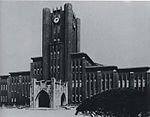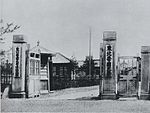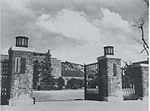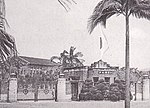Imperial_Universities
Imperial Universities
Group of universities in the former Japanese Empire
The Imperial Universities (Kyūjitai: 帝國大學, Shinjitai: 帝国大学, teikoku daigaku, abbr.: 帝大 teidai) were founded by the Empire of Japan between 1886 and 1939, seven in Mainland Japan (now Japan), one in Korea under Japanese rule (now the Republic of Korea) and one in Taiwan under Japanese rule (now Taiwan). They were run by the imperial government until the end of World War II.
The name 'Imperial University' was initially used by what is now the University of Tokyo, the nation's first university. Although it was originally established under its current name, the Meiji government renamed it in 1886. In 1897, when it was decided to establish the nation's second university in Kyoto, the original Imperial University was renamed Tokyo Imperial University. Meanwhile, the newly established university was named Kyoto Imperial University.[1]
Unlike in Europe and North America, modern higher education in Japan mostly originated as national projects. There had been no private universities in Japan until 1920, when Keio and Waseda were granted university status.[2] Thus, for the majority of its pre-war history, Japan's political, business and academic establishments predominantly consisted of alumni of the Imperial Universities and universities abroad, which further strengthened the prestige and power of these universities.
Today, these university are no longer 'imperial', as Japan ceased to be an empire after the loss of World War II, and are often described as the former Imperial Universities (旧帝国大学, kyū-teikoku daigaku, abbr. : 旧帝大 kyū-teidai). They are viewed as some of the most prestigious in Japan. These former imperial universities are generally perceived as Japan's equivalent of the Ivy League in the United States, Golden Triangle in the United Kingdom, and the C9 League in China.[3] The alumni club of these nine imperial universities is called Gakushikai (学士会).[4]
Unlike Taihoku Imperial University (renamed in 1945 to National Taiwan University) in then-Japanese Taiwan, the Keijō Imperial University in then-Japanese Korea was closed by the United States Army Military Government in Korea (USAMGIK) with U.S. Military Ordinance No. 102. Seoul National University was built by merging nine schools in Seoul and the remaining properties of Keijō Imperial University (Kyŏngsŏng University). The National Taiwan University and Seoul National University are today among the most prestigious universities of Taiwan and Korea.








